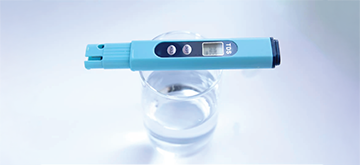
Main Sources of high TDS in water
PUBLISHED ON: 28-Mar-2024
Water is a powerful drink and a universal solvent, making it capable of dissolving molecules from several substances. These dissolved particles in water are referred to as Total Dissolved Solids (TDS), which affect the water’s flavour and safety. TDS consists of inorganic salts like calcium, magnesium, potassium, sodium, bicarbonates, chlorides, and sulfates, and some small amounts of organic matter. Understanding your water's TDS level provides a picture of the overall quality of your water.
In this blog, we explore the main natural and human-made sources of high TDS in your water supply and how you can tackle them effectively.
What are the Main Sources of High TDS in Water?
Generally, the TDS level of water is measured in Parts Per Million (PPM) or milligrams per liter (mg/l), with higher TDS indicating more minerals dissolved in the water. And, water with a TDS below 500 mg/l is safe for drinking.
Natural Sources of High TDS
Groundwater Seepage from Rocks
As water flows through underground rock layers, it picks up minerals like calcium, magnesium, and sodium. Areas with hard water typically have high levels of these naturally dissolved salts.
Seawater Intrusion in Coastal Areas
In coastal cities, excessive groundwater extraction often leads to saline water intrusion. This raises the TDS levels significantly due to sodium, chloride, and other salts from seawater mixing into freshwater aquifers.
Soil and Clay Runoff
Natural erosion and rainfall can cause clay, silt, and fine particles to mix with water sources, contributing to higher turbidity and mineral content.
Man-Made Sources of High TDS
Agricultural Runoff
The overuse of fertilisers and pesticides leads to excess nitrates, phosphates, and sulphates entering rivers and groundwater. This is especially common in regions with intensive farming.
Industrial Waste Discharge
Factories and manufacturing units may release untreated wastewater into nearby streams or directly into the soil. This introduces heavy metals like lead, arsenic, chromium, and other toxic substances – all of which contribute to high TDS levels.
Sewage and Urban Wastewater
Improperly treated sewage water contains organic matter, detergents, and chemicals, which seep into underground water supplies or pollute rivers, raising both biological and chemical TDS.
Corroded Plumbing Systems
In older buildings, rusted or corroded pipes can release iron, copper, and other particles into the water, especially in overhead storage tanks.
Finding Remedies for Tackling Elevated TDS
Advanced Purification
To counter excessive TDS, you can opt for water purifiers with RO, UV, or a combination of RO+UV water purifiers. Reverse Osmosis (RO) uses a semi-permeable membrane to successfully lower TDS levels. It passes water under pressure to filter out excess TDS and harmful bacteria and viruses from the water. This procedure guarantees complete purification and effectively reduces high TDS. UV, on the other hand, disinfects the water, removing bacteria and viruses, delivering water pure and safe as water boiled for 20+ minutes. Some of the best RO water purifiers by Aquaguard come with an RO filter, a 2-year filter life, and advanced technologies that not just purify water but also add minerals to the water.
• Aquaguard Marvel RO+UV+UF 2X Copper Water Purifier
Equipped with RO+UV+UF purification, this model removes excess TDS, bacteria, and viruses while enriching water with the goodness of Copper. It's 2-year filter life, and the Mega Sediment Filter ensures long-lasting performance and cleaner water—ideal for homes with high TDS and multiple water sources.
• Aquaguard Glory RO+UV+UF 2X Water Purifier
This purifier uses RO technology to reduce TDS, while UV and UF stages eliminate microbial impurities. It features a Mega Sediment Filter for better pre-filtration and offers a 2-year filter life, reducing maintenance needs. Perfect for Indian households seeking reliable, long-term water purification across diverse water qualities.
Managing Sources
TDS pollution can be avoided by following recommended agricultural practices, disposing of trash properly, and treating industrial effluents. It is possible to drastically lower the total TDS levels in water sources by addressing them.
Education and Community Awareness
Encourage community awareness and education initiatives that focus on conserving water and avoiding pollution. Promoting environmentally friendly behaviors and appropriate waste disposal helps with source management and lessens the overall effect on TDS levels.
Summing Up
Whether it’s natural geology, urban waste, or industrial pollution, high TDS in water is a growing concern. Identifying the source of contamination is the first step toward choosing the right water purification system. With Eureka Forbes’ trusted RO water purifiers, you can protect your family from unwanted impurities and enjoy water that’s clean, tasty, and safe.
Frequently Asked Questions
What causes high TDS in drinking water?
High TDS (Total Dissolved Solids) in drinking water can result from a mix of natural and man-made sources. Common causes include minerals like calcium, magnesium, and sodium from rocks and soil, as well as contaminants from agricultural runoff, industrial waste, sewage, and even seawater intrusion in coastal areas.
Is it safe to drink water with high TDS?
Water with a TDS level below 500 mg/l is generally considered safe for drinking. However, very high TDS levels can affect the taste and potentially pose health risks, especially if they include harmful salts or heavy metals. It’s best to treat high-TDS water using a reliable RO water purifier to ensure safety.
Which water purifier is best for reducing TDS levels?
A RO (Reverse Osmosis) water purifier is ideal for reducing high TDS. Models like Aquaguard Aura 2X Life RO + UV with Copper Water Purifier and Aquaguard Delight RO+UV 2X Water Purifier are equipped with advanced purification technologies that effectively remove excess TDS, heavy metals, and microbes, ensuring clean and great-tasting drinking water.
References
- Wang, J., Yeh, L., Shih, C., Tu, K., & Chien, L. (2020). Dietary Sodium Intake and Risk of Cardiovascular Disease: A Systematic Review and Dose-Response Meta-Analysis. Nutrients, 12(10). https://doi.org/10.3390/nu12102934/ Accessed on 27/02/2024.
